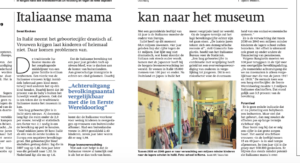ITALIAN MOTHERS ARE RARE ARTIFACTS NOW
In Italy, the birth rate is falling dramatically. In the event that an Italian woman has a child, it is at the average at the age of 32. Moreover, Italy is the European country with the largest number of childless women. The “demographic recession” is the worst in 100 years.
The traditional Italian mother with the role of the caretaker of a large family is no longer. Almost a quarter of Italian women no longer have a child at all. Women who want to become pregnant keep it at one child.
Thirty percent of babies are born outside of marriage. Here is another sign that the traditional Italian mother is now an artifact.
Tendency
The fact that the Italian woman produces few children is not new. The average number of children per woman has been well below 2.0 for decades. To maintain a population, every woman must have 2.1 children statistically. The figure in 2017 was 1.32, a decade earlier 1.46. The fact that the population remained at the same level until a few years ago was only due to immigration.
However, large-scale immigration has come to an end. In addition, the Italian tendency to have few children has spread to women of foreign origin. In 2010 a foreign woman had an average of 2.43 children; seven years later that figure was already below 2.0. It does not help that the Italian woman is quite old when her child sees the light. With an average age of 32, the Italian mother is the oldest in Europe.
Risk for sustainability
Italy currently has 60.4 million inhabitants; four years ago that figure was closer to 61 million. The decline in population is still modest. On average, Italians, along with the Japanese, live to be the oldest in the world. In any case, 15,000 over-100s already live in Italy. The decline is still modest, but if the trend continues, the consequences for the future cannot be foreseen.
“In recent decades, the imbalance in the age structure of the population has increased. A demographic recession has been taking place in recent years. A low birth rate and an aging population has led to overrepresentation of the elderly compared to the young. This is a risk factor for the sustainability of our socio-economic system,” says Giancarlo Bangiardo, head of the National Institute of Statistics. The expectation is that between 2030 and 2040, one million fewer children will attend primary school. The effect is of course also disastrous on the financing of pensions, among other things.
According to Bangiardo, we have to go back a hundred years in time to see a similar population decline. “The numerical decline that we are now experiencing is only comparable with the years 1917 and 1918.” But the cause at that time was a high death rate. The First World War took 1.2 million Italian victims (3.5% of the population).
In the unlikely event that a birth wave suddenly occurs, the effects would only be evident in the very long term. There is another figure that is very worrying. The number of fertile women–between the ages of 15 and 49–is decreasing rapidly. In the last ten years, the number of fertile Italian women has decreased by 900,000.
Therefore, there are fewer and fewer potential mothers in Italy.

Italian mothers are maybe rare artifacts but that is not the case with regard to the Italian mother-in-law. Read more.

